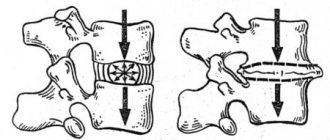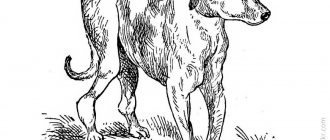Infectious hepatitis in dogs in veterinary medicine is called adenovirus, viral hepatitis and fulminant liver failure. It belongs to the category of serious contagious viral diseases, characterized by very extensive symptoms and causing damage to liver cells.
Any dog can get hepatitis, regardless of breed and age category. Most often, puppies aged from one to three months are affected. In pets after three years of age, this disease is rarely diagnosed. The disease can occur in isolated cases or have epizootic outbreaks.
Etiology of the disease
Infectious hepatitis in dogs is caused by the DNA virus Adenovirus caninae. All its strains have equally low virulence. It is similar to laryngotracheitis. The virus is resistant to low and high temperatures. It is also unaffected by chloroform, some acids, ether and methanol.
The virus begins to develop in the nasopharynx, larynx, esophagus and tonsils. Later it descends to the internal organs, submandibular and retropharyngeal lymph nodes. However, it is most localized in liver cells. The waste products of the virus cause the development of inflammation, degeneration and necrotics of the liver, leading to disruption of its functioning. Malfunctions in the functioning of the gastrointestinal tract and central nervous system also begin.
In addition, destruction of the renal vessels occurs. Multiple foci of inflammation develop, hemorrhages and perivascular edema appear. The poisons and toxic substances released by the adenovirus destroy the vascular walls, increasing their permeability. If you do not help the animal in time, it will die.
How can a dog get hepatitis?
The most common way of infection is contact of a sick dog with a healthy one. Infectious hepatitis of dogs is transmitted through contact with feces, urine and other secretions of a sick individual.
In addition, a dog can get sick by eating from a bowl or drinking from the drinking bowl of a sick animal. The risk group includes pets with weak immune systems. Animals that are not properly kept, fed, or monitored for their health often get sick.
Epizootology: under what conditions the virus is most dangerous
Rubart's disease is dangerous for pets, as well as for all members of the canine family - wolves, jackals, foxes and arctic foxes. The virus is more dangerous for unvaccinated puppies 1.5-12 months old. After 3 years, the disease is registered much less frequently or occurs in a milder form.
It is noteworthy that humans, rodents and cats can become hidden sources of the disease, that is, not only sick dogs are a reservoir for infection. The virus is released into the external environment from sick dogs or virus carriers with saliva, mucus from the sinuses, discharge from the eyes, feces and urine. This process can take up to several months, which means the pet is potentially dangerous for healthy individuals.
Viral hepatitis can occur in the form of one-time episodes when the dog is kept alone. But in nurseries, with crowded housing or in a pack of stray dogs, the intensity of infection can increase to 75-80% with a mortality rate of up to 30-35%. This means that out of 10 individuals, 3-4 dogs die.
In nurseries, the virus spreads quickly through feed, water, and common bedding. It is transferred from cells to cells on the clothes of service personnel, through equipment when cleaning feces.
The speed of spread and susceptibility to the virus directly depends on the resistance of the dog’s body. Factors provocateurs:
- systematic hypothermia;
- overheating;
- low-quality feed;
- minimum vitamins and minerals.
Concomitant diseases or infectious pathologies (plague, streptococcosis, toxoplasmosis, etc.) increase the risk of infection with infectious hepatitis and in almost 99% of cases lead to death. Therefore, in order to protect your dog from accidents, you need to carefully monitor your pet’s health from puppyhood.
Forms of viral hepatitis in dogs
The incubation period for the disease lasts from six to fifteen days. Hepatitis is divided into four groups. It happens:
- lightning fast;
- sharp;
- chronic;
- latent.
Each form has its own course and forecasts.
Fulminant hepatitis
Fulminant hepatitis leads to the death of the animal within two to twelve hours. Most often, the dog has convulsions, but jaundice does not have time to develop. Lifetime diagnosis of the disease in an animal does not produce results. This course of the disease does not occur in vaccinated dogs.
Acute hepatitis
The acute course can last from two to ten days. A sick dog becomes lethargic, apathetic and loses its appetite. He has vomiting of bile and diarrhea with blood. The temperature rises to maximum levels, breathing is depressed, and tachycardia develops.
There is an enlargement of the lymph nodes and liver. Also, during an ultrasound examination, fluid accumulation in the peritoneum is often noted. It accumulates due to compression of the portal vein by the liver and poor circulation. A sweetish, fetid odor begins to emanate from the mouth.
Chronic hepatitis
The chronic type of disease develops in adult, vaccinated dogs. It does not have clear symptoms. The animal occasionally experiences vomiting and upset stools. Chronicle pets have a low weight, dull coat and are characterized by low activity. In addition, itching may occur, which cannot be relieved with antiallergic drugs.
Latent hepatitis
This type of disease is asymptomatic. The virus remains dormant for a long time. However, when the immune system weakens, it wakes up and goes into the acute phase. Stress, poor nutrition or pregnancy can weaken the body's defenses. Since the disease remains in the body in an inactive state for a long time, it will not be possible to determine where and under what circumstances the dog became infected.
The most dangerous form of the disease is fulminant hepatitis. When it occurs, the animal cannot be saved.
Symptoms of infectious hepatitis in dogs
Depending on the form of the disease, infectious hepatitis in dogs will occur with different symptoms. Each form has its own characteristic signs, but there are also general symptoms indicating the development of the disease.
The presence of hepatitis in a dog is indicated by an increase in temperature, poor appetite, thirst, depression and apathy. The animal does not respond to attention from the owner and is reluctant to go for a walk. The pet tries to lie on its left side, and when the area under the right rib is palpated, it begins to writhe and whine. At the same time, the liver increases in size and becomes very inflamed.
In addition to elevated temperatures and refusal to eat, the dog develops the following symptoms:
- lethargy, lack of response to stimuli, desire to hide and lie down more;
- lack of appetite and constant thirst;
- rapid breathing, stuffy nose, enlarged submandibular lymph nodes;
- diarrhea mixed with blood and mucus, vomiting with bile;
- dark colored urine;
- weakness and numbness of the limbs;
- yellowing of the eyeballs and mucous membranes;
- bleeding gums.
When the disease passes into the chronic stage, the symptoms change somewhat and acquire disastrous consequences for the body. Since chronic hepatitis develops over a long period of time, its symptoms will include:
- catarrhal symptoms (discharge from the nose and eyes);
- fever, photophobia and spatial disorientation;
- clouding of the cornea;
- edema and convulsive syndrome;
- weight loss, low-grade fever;
- problems with bowel movements and gas formation;
- periodic vomiting.
These symptoms of infectious hepatitis in dogs are not as obvious as in its acute course, so it will be more difficult to identify the disease. However, if the owner notices at least one of the above signs in the pet, he should immediately take him to the veterinarian.
Diagnosis of the disease
To understand that the veterinarian is dealing with Hepatitis infectiosa, and not enteritis, distemper or another disease with similar symptoms, you should conduct a complete diagnosis of the pet’s body, which consists of:
- blood and urine screening;
- analysis of biological fluids;
- ultrasound examination of the liver;
- histology of liver tissue if test results are similar to liver cirrhosis.
After receiving the screening results, the veterinarian selects therapy for the pet to relieve the disease.
Diagnostics
Even an experienced veterinarian will not be able to immediately give an unambiguous analysis in the case of hepatitis. A complete medical history will be required, compiled from anamnestic data, an examination of the animal and the results of laboratory blood tests. Among other things, sometimes a biopsy is also performed.
The doctor needs to figure out whether the animal is suffering from any infectious disease that can show a similar clinical picture. X-rays are also used to analyze how much the liver is enlarged.
Therapy for infectious hepatitis
Treatment of infectious hepatitis in dogs will be symptomatic. To relieve this dangerous disease, the animal is prescribed antiviral drugs, penicillin antibiotics, liver medications and antihistamines.
To normalize liver function, a sick pet is prescribed decoctions and tinctures based on herbal components, as well as hepatoprotectors. To improve immunity, special serums and vitamins are administered, and to normalize the functions of the digestive tract, the animal is given drugs with lactobacilli and cleansing enemas are given.
To eliminate pain, the dog is prescribed drugs with sedative and analgesic effects. To remove intoxication, pets are given saline solution. During treatment, a strict diet is introduced, completely eliminating fatty foods.
If a sick animal is kept in a kennel, in order to avoid an epidemic and destroy the canine infectious hepatitis virus, the premises and household items are disinfected. After such procedures, the causative agent of the disease dies and the risk of infection of other animals is minimized.
Treatment
When choosing treatment methods, the causes of the disease and its type are determined. Prescribed drugs that remove toxins from the body, antibacterial agents, painkillers, and support the immune system. To strengthen the liver and restore its functions, hepatoprotectors are prescribed.
The dog owner must carefully consider the pet’s diet during the treatment period. It is better to give food in small portions 3-4 times a day. Food should be warm. It is useful to give broth at one of the feedings: alternate chicken and fish. Avoid fatty foods completely. The best option for the duration of treatment is special balanced medicinal feed.
Make sure your dog drinks water. It is changed regularly, only filtered water is suitable.
During treatment, the dog should not be disturbed; most of the time it should be kept in bed. The bed must be arranged in a warm place.
Preventive actions
The first and most important way to protect your pet from viral hepatitis is timely vaccination. The first vaccination is given to the dog at the age of two months, and repeated after a year. In the future, your four-legged friend will be vaccinated annually.
To prevent hepatitis, veterinarians recommend using the Nobivak, Kanvak, Avangard or Hexadog vaccines.
In addition to vaccinations, the dog needs to be fed properly and in a balanced manner. Her diet should contain all the necessary minerals and vitamins. We should not forget about the hygiene of the animal and the cleanliness of the room where it is kept.
It should be noted that the causative agent of infectious canine hepatitis is resistant to many disinfectants, including bleach. The virus can be destroyed only with phenol, formaldehyde and high temperatures.
Good to know
- Vanguard vaccine
- Eurikan dhppi2
- Rabizin for dogs
- Vanguard 5 (instructions for use for dogs)
- Vaccine Vanguard 7
- Multikan 8 for dogs
- Instructions for the use of Vangard complex vaccinations
- Nobivac Lepto for dogs
- Vaccination Eurikan: Instructions for use
- Nobivac Rabies: Instructions
- How to use Nobivak RL for dogs
- Rabix vaccination
- Vaccine Multikan-6: for dogs
- Instructions for using the hexadog vaccine for dogs
- Eurican (DHPPi2, LR, L, R, DHPPi). Why do dogs need Eurican DHPPi + LR?
- Instructions for use of the Eurican DHPPI vaccine (DHPPI2, dhppi2 lr and dhppi2 l) for dogs











